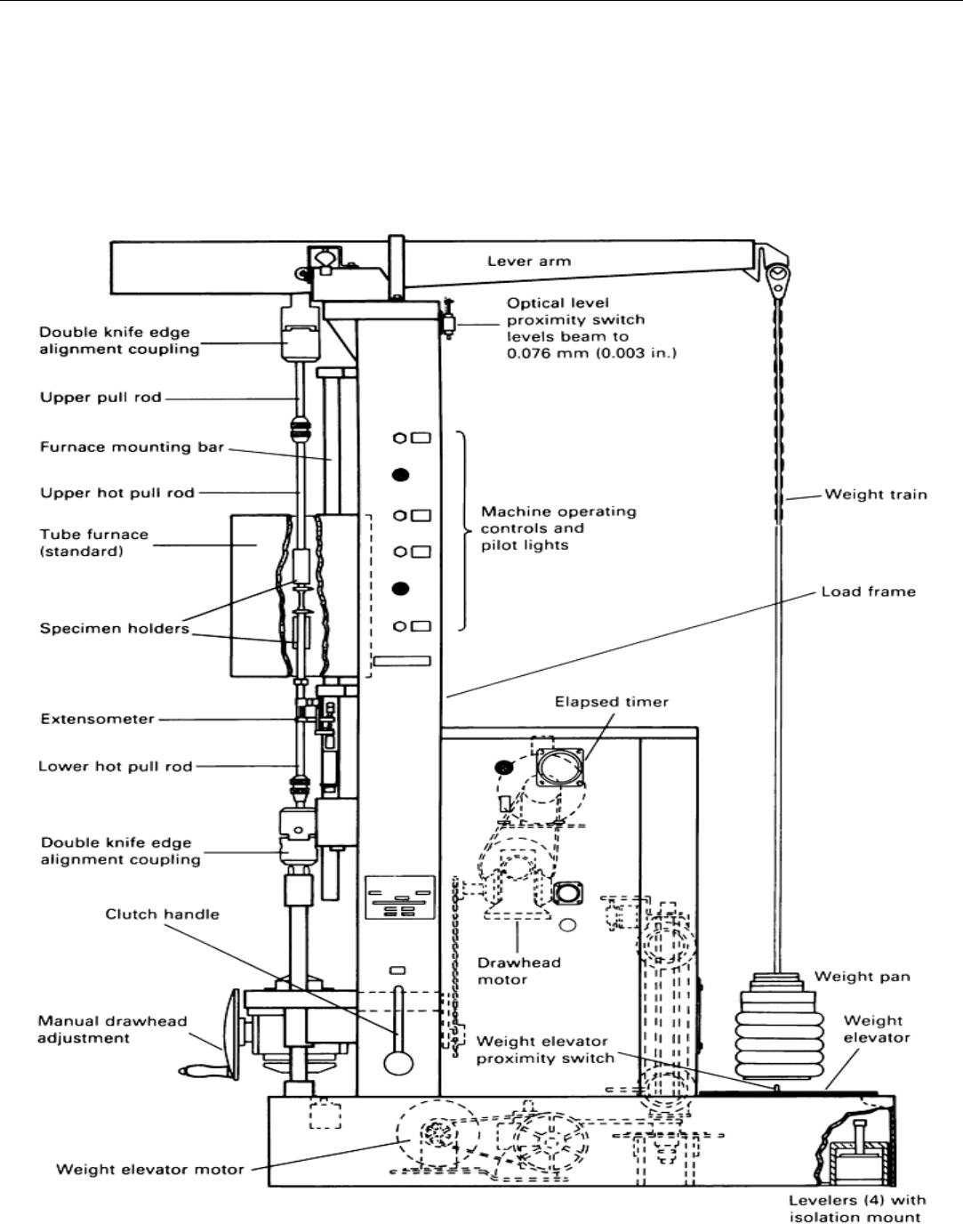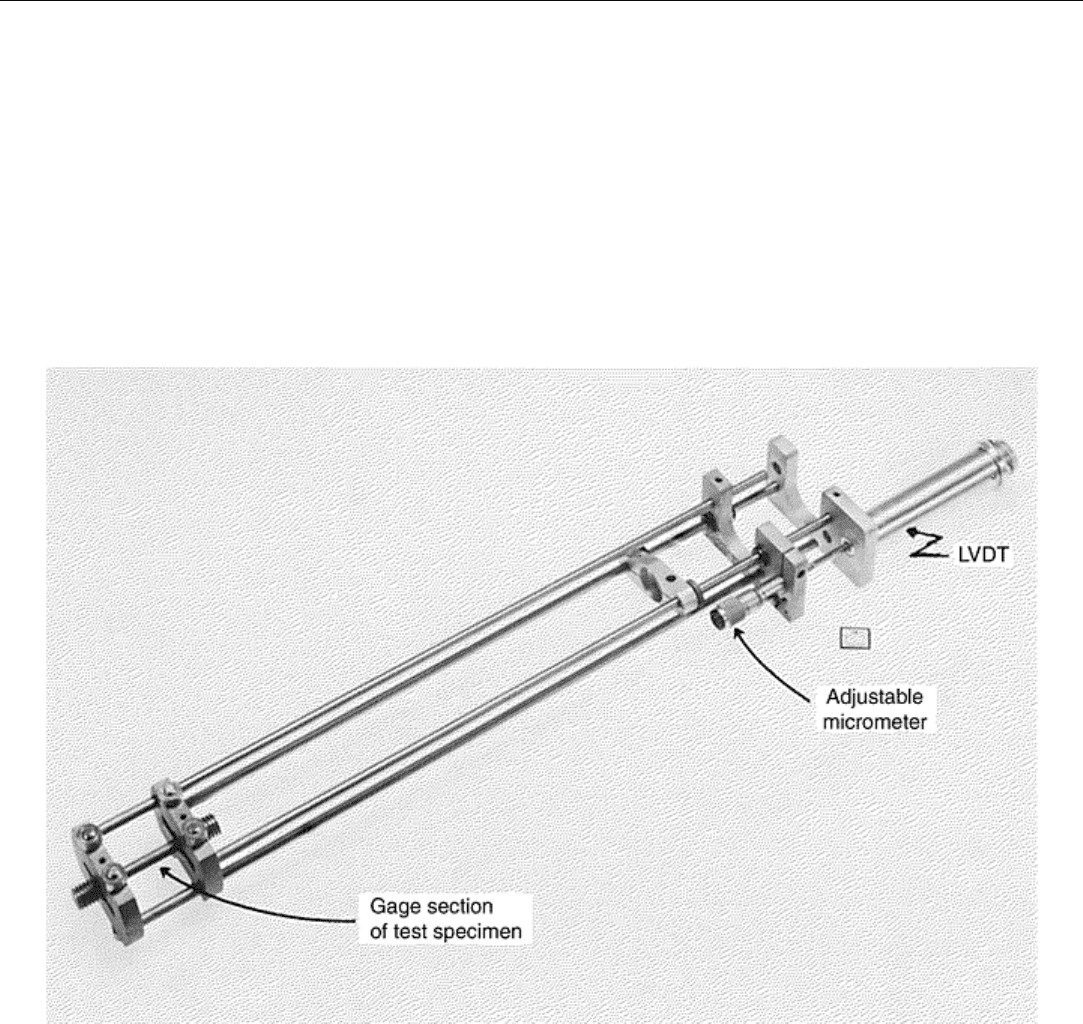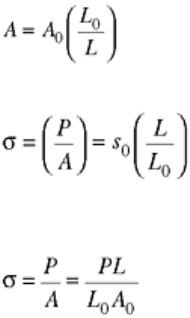ASM Metals HandBook Vol. 8 - Mechanical Testing and Evaluation
Подождите немного. Документ загружается.


Designation Title
ASTM E 139 Standard Test Methods for Conducting Creep, Creep-Rupture, and Stress-Rupture Tests of
Metallic Materials
BS 3500 Methods for Creep and Rupture Testing of Metals
DIN 51226 Creep Testing Machines for Tensile Stress Testing of Metallic Materials
ISO 204 Uninterrupted Uniaxial Creep Testing in Tension of Metallic Materials
ISO 7500 (Part
2)
Verification of Applied Load—Tension Creep Testing Machines
Footnote
*
The section “Creep Properties” was adapted from Ref 1
with additional content by R.W. Hayes, Metals
Technology, Inc. The remaining sections of this article were adapted from “Creep, Stress-Rupture, and Stress-
Relaxation Testing” in Volume 8 of the 9th Edition Metals Handbook. The section “Constant-Stress Testing”
was updated by N.L. Carroll, Applied Test Systems Inc.
Creep and Creep-Rupture Testing*
General Methods and Test Factors
Creep behavior is generally determined by uniaxial loading of test specimens heated to temperature in some
environment. Creep-rupture experiments measure the deformation as a function of time to failure. If strain-time
behavior is measured, but the test is stopped before failure, this is termed an interrupted creep experiment.
Finally, if an inadequate strain-measuring system or no attempt to determine length is employed, and the test is
run to fracture, a stress-rupture experiment results.
In terms of data that characterize creep, the stress-rupture test provides the least amount, because only the time-
to-rupture and strain-at-rupture data are available for correlation with temperature and stress. These data and
other information, however, can be obtained from creep-rupture experiments. Such additional measurements
can include elastic strain on loading, amount of primary creep strain, time to onset of secondary, creep, steady
state creep rate, amount of secondary creep, time to onset of tertiary creep, time to 0.5% strain, time to 1.0%
strain, and so on. All of these data can be fitted to equations involving temperature and stress. An interrupted
creep test provides much the same data as a creep-rupture experiment within the imposed strain-time
limitations.
Direction of Loading. Most creep-rupture tests of metallic materials are conducted in uniaxial tension. Although
this method is suitable for ductile metals, compressive testing is more appropriate for brittle, flaw-sensitive
materials. In compression, cracks perpendicular to the applied stress do not propagate as they would in tension;
thus, a better measure of the inherent plastic properties of a brittle material can be obtained.
In general, loading direction has little influence on many creep properties—for example, steady state creep rate
in ductile materials (Ref 32). However, even in these materials, the onset of third-stage creep and fracture is
usually delayed in compression compared with tension. This delay is due to the minimized effect of
microstructural flaws and the inability to form a “neck-like” mechanical instability. For brittle materials, the
difference in behavior between tension and compression can be extreme, primarily due to the response to flaws.
Consequently, care must be exercised when using compressive creep properties of a brittle material to estimate
tensile behavior.
Test specimens for uniaxial tensile creep-rupture tests are the same as those used in short-term tensile tests.
Solid round bars with threaded or tapered grip ends or thin sheet specimens with pin and clevis grip ends are
typical. However, many other types and sizes of specimens have been used successfully where the choice of
geometry was dictated by the available materials. For example, small threaded round bars with a 12 mm (0.47
in.) overall length and a 1.52 mm (0.06 in.) diameter by 5 mm (0.2 in.) long reduced section have been used to
measure transverse stress-rupture properties of a 13 mm (0.51 in.) diameter directionally solidified eutectic
alloy bar (Ref 33).
In the case of uniaxial compression testing, specimen design can be simple small-diameter right cylinders or
parallelepipeds with length-to-diameter ratios ranging from approximately 2 to 4. Larger ratios tend to enhance
elastic buckling, and smaller ratios magnify the effects of friction between the test specimen and the load-
transmitting member. These specimen geometries are well suited for creep testing when only a small amount of
material is available or when the material is difficult to machine.
Environment. The optimum conditions for a creep-rupture test are those in which the specimen is influenced
only by the applied stress and temperature. This rarely occurs, particularly at elevated temperatures, and these
conditions do not exist for real structures and equipment operating under creep conditions. For example, turbine
blades are continuously exposed to hot, reactive gases that cause corrosion and oxidation.
Reactions between the test environment and material vary greatly, ranging from no visible effect to large-scale
attack. For example, creep-rupture testing of aluminum, iron-chromium-aluminum, nickel-chromium, and
nickel-base superalloys at elevated temperatures in air can generally be accomplished without problems
because these materials form thin, stable, protective oxide films. This is not the case for refractory metals
(molybdenum, niobium, tantalum, and tungsten) and their alloys, due to their strong reaction with oxygen,
which leads to the formation of porous, nonprotective, and in some cases, volatile oxides. Environmental
effects such as oxidation and corrosion reduce the load-bearing cross-sectional area and can also facilitate the
formation and growth of cracks.
Reactions are also possible in inert atmospheres (such as vacuum) and in reducing gas environments. Elevated-
temperature testing in vacuum can result in the loss of volatile alloying elements and subsequent loss of
strength. Exposure to reducing gases can result in the absorption of interstitial atoms (carbon, hydrogen, and
nitrogen), which may increase strength, but also induce brittleness.
A “perfect” environment does not exist for all creep testing. The appropriate choice depends on the material, its
intended use, and the available environmental protection methods. If creep mechanisms are being determined,
then the atmosphere should be as inert, or nonreactive, as possible. However, if the material is to be used in an
unprotected state in a reactive atmosphere, then creep testing should reflect these conditions.
Creep data from inert atmosphere tests cannot be used for design purposes when the material will be exposed to
conditions of severe oxidation. However, if environmental protection methods, such as oxidation- or corrosion-
resistant coatings, are available, then testing in inert gas is acceptable, and the resulting data can be used for
design.
If reactions occur between the test environment and the specimen, the resultant creep-rupture data will not
reflect the true creep properties of the material. Rather, the measured data are indicative of a complex
interaction between creep and environmental attack, where the effects of environmental attack become more
important in long-term exposure.
Footnote
*
The section “Creep Properties” was adapted from Ref 1
with additional content by R.W. Hayes, Metals
Technology, Inc. The remaining sections of this article were adapted from “Creep, Stress-Rupture, and Stress-
Relaxation Testing” in Volume 8 of the 9th Edition Metals Handbook. The section “Constant-Stress Testing”
was updated by N.L. Carroll, Applied Test Systems Inc.
References cited in this section
32. G.P. Tilly and G.F. Harrison, Interpretation of Tensile and Compressive Creep Behavior of Two Nickel
Alloys, J. Strain Anal., Vol 8, 1973, p 124–131
33. H.H. Gray, “Transverse Tensile and Stress Rupture Properties of γ/γ′ - δ Directionally Solidified
Eutectic,” NASA TMX-73451, 1979

Creep and Creep-Rupture Testing*
Test Stands
The test stand is designed to apply static stress to a test specimen for an extended period of time at a constant
elevated temperature. Typical test stands have a balance beam that connects the test specimen to a weight pan,
as shown in Fig. 6. Ratios of 3 to 1 up to 20 to 1 are commonly used between the weight pan and the specimen.
The lower ratios are used to provide optimum accuracy at lower loads. The weight pan is part of the overall
weights and frequently is suspended with a chain to prevent bending moments on the load train.
Fig. 6 Schematic of a test stand used for creep and stress-rupture testing

On the specimen side of the machine, a balance beam leveling motor is recommended to compensate for
elongation of the test specimen. If this is not available, the balance beam may become unlevel, thus changing
the calibration of the weight system. However, properly designed creep testing machines will maintain load
accuracy well within ASTM requirements, even when out of level by as much as ±10. °.
The procedure for calibration of weights is given in ASTM E 4, “Standard Practice for Force Verification of
Testing Machines.” The weights should be verified within a limit of 1% at least every 5 years. Additionally, the
weight of the overall load train system should be verified within a limit of 1% at least once a year, except for
test stands for long-term tests that last more than 1 year.
The test specimen is connected to the balance beam through the load train, a system of pull rods and couplings
manufactured from high-temperature alloys that are capable of maintaining strength and corrosion resistance at
the test temperatures encountered. The load train should be machined and assembled such that minimum
bending moments are imposed on the test specimen. ASTM recommends a maximum of 10% bending strain,
compared with the axial strain due to misalignment of the load train. To overcome this problem, alignment
couplings (such as ball and socket or knife-edge systems) are used in the load train to facilitate self-alignment.
Vibration and shock loads can have a significant effect on the end results in creep and stress-rupture testing.
Care must be taken in selecting the test site to ensure that vibration or shock is minimal. Additionally, the test
stand should be isolated from the floor with a vibration-damping material such as cork or rubber. The leveling
motor can introduce vibration that may affect long-term creep tests, or shorter tests if the vibration is
significant.
A timer that automatically records the time to rupture is also included on most test stands. During creep tests,
the time must be recorded with the creep values.
Footnote
*
The section “Creep Properties” was adapted from Ref 1
with additional content by R.W. Hayes, Metals
Technology, Inc. The remaining sections of this article were adapted from “Creep, Stress-Rupture, and Stress-
Relaxation Testing” in Volume 8 of the 9th Edition Metals Handbook. The section “Constant-Stress Testing”
was updated by N.L. Carroll, Applied Test Systems Inc.
Creep and Creep-Rupture Testing*
Furnaces
Furnaces used in creep and stress-rupture testing generally are tubular, with an electrical-resistance winding
that heats the test specimen through radiation in an air atmosphere. These furnaces can have single or multiple
heating zones. The tube is located in a vertical position, with the pull rods connected to the specimen. Care
must be taken to seal the opening of the furnace without interfering with the alignment of the load train or the
action of the linkage for creep tests.
Temperature Control and Measurement. Materials properties frequently are affected by temperature. The
requirement for temperature control of creep and stress-rupture tests is ±1.7 °C (±3 °F) when testing at 982 °C
(1800 °F) and below, and ±2.8 °C (±5 °F) above that value. Maintaining control requires practice.
Temperature measurement systems require a transducer to convert a temperature differential to an electrical
signal. The transducer typically is a thermocouple that is attached directly to the specimen. Specimens with a
gage length 25.4 mm (1.0 in.) or greater require two thermocouples; specimens with gage lengths 50.8 mm (2.0
in.) or greater require a third thermocouple.
The thermocouple should maintain in firm and close contact with the test specimen during the entire test.
Inherent errors are associated with thermocouples, including calibration error, drift due to metallurgical changes
to the thermocouple junction during the test, lead wire error, attachment gap error, radiation error, and
conduction error.
Footnote

*
The section “Creep Properties” was adapted from Ref 1
with additional content by R.W. Hayes, Metals
Technology, Inc. The remaining sections of this article were adapted from “Creep, Stress-Rupture, and Stress-
Relaxation Testing” in Volume 8 of the 9th Edition Metals Handbook. The section “Constant-Stress Testing”
was updated by N.L. Carroll, Applied Test Systems Inc.
Creep and Creep-Rupture Testing*
Extensometers
When creep data are required, the specimen strain must be measured as a function of time. With most metals
this is difficult because use of strain-measuring transducers generally is not practical at the test temperatures
encountered. A mechanical linkage must then be attached to the specimen to transmit the strain to the strain-
measuring equipment outside the high-temperature environment.
The most commonly used strain transducer is the linear variable differential transformer, which consists of a
movable metal core that changes the electrical characteristics with the small motion associated with strain
measurements (Fig. 7). Linkages that attach to the specimen typically are made of alloys that can withstand the
test temperatures encountered. The linkage can be attached either to the gage length or on the shoulders outside
the gage length.
Fig. 7 Typical rod-and-tube-type extensometer for elevated-temperature creep testing. Extensometer is
clamped to grooves machined in the shoulders of the test specimen.
Care must be taken to ensure that the measured deformation occurs only in the gage section. Thus,
measurements based on the relative motion of parts of the gripping system above and below the test specimen
are generally inaccurate because the site of deformation is unknown. Extensometry systems are currently
available that attach directly to the specimen (shoulders, special ridges machined on the reduced section, or the
gage section itself) and transmit the relative motion of the top and bottom of the gage section via tubes and rods

to a sensing device such as a linear variable differential transformer (LVDT). Figure 7 illustrates such a system.
These systems are quite accurate and stable over long periods of time.
Typical problems encountered with the use of extensometers include:
• Error due to strain in the fillet of the test specimen when the extensometer linkage is attached to the
shoulder (see Ref 34 for strain corrections)
• Fracture where the extensometer linkage attaches to the specimen gage length
• Error in strain measurement when the extensometer linkage is attached such that it measures the strain
only on one side of the specimen
• Error due to slippage of extensometer linkage on the gage section of ductile specimens
• Damage to linkages and extensometers when the specimen fails
• Bending strain introduced to smaller test specimens, particularly strip specimens, due to the weight of
the linkage and extensometer
Other methods of direct strain measurement exist and, under certain circumstances, are suitable. At low
temperatures, strain gages can be directly bonded to the gage section and can be used to follow deformation
over the range of extension for which the strain gage is valid. For specimens that will undergo reasonable
deformations (ε > 1.0%), the distance between two gage marks can be optically tracked with a cathetometer as a
function of time. While the location of strain is known, use of this technique is operator dependent and is
generally limited to tests of less than 8 h or greater than 100 h in duration in order to permit sufficient readings
to properly define the creep curve.
Footnote
*
The section “Creep Properties” was adapted from Ref 1
with additional content by R.W. Hayes, Metals
Technology, Inc. The remaining sections of this article were adapted from “Creep, Stress-Rupture, and Stress-
Relaxation Testing” in Volume 8 of the 9th Edition Metals Handbook. The section “Constant-Stress Testing”
was updated by N.L. Carroll, Applied Test Systems Inc.
Reference cited in this section
34. J.M. Thomas and J.F. Carlson, Errors in Deformation Measurements for Elevated Temperature Tension
Tests, ASTM Bullein, May 1955, p 47–55
Creep and Creep-Rupture Testing*
Other Testing Considerations
Constant Load Versus Constant Stress Testing. Most uniaxial creep and stress-rupture tests are conducted under
constant-load conditions. Although the method is simple, the stress in the gage section varies with strain (time).
This can be seen by considering a bar of length L
0
and cross-sectional area A
0
subjected to a tensile load P. At
time t = 0, the initial engineering stress on the bar is:
(Eq 4)
With the assumption of uniform deformation during creep, the bar lengthens to L and the cross-sectional area
decreases to A, because volume must be conserved:
LA = L
0
A
0
(Eq 5)
Therefore:

(Eq 6)
and the true stress on the bar is:
(Eq 7)
Methods have been devised to account for the change in cross-sectional area during creep. These are based on a
rearranged form of Eq 7, where:
(Eq 8)
By maintaining PL at a fixed value, a constant stress test can be conducted. In general, the strain-time behavior
under constant stress conditions follows the general forms of primary, secondary, and tertiary stages (Fig. 1).
However, the period of time spent in primary and secondary creep under constant stress can be much longer
than under an identical engineering stress (constant load). Hence, rupture life is longer under constant stress
conditions.
Failure under constant stress conditions eventually occurs due to some microstructural and/or mechanical
instability in the same manner as a constant load experiment. Once a local variation in cross-sectional area is
formed, the actual stress is higher than the imposed constant stress, and further deformation concentrates at this
location.
In reality, the basic assumptions of conservation of volume and/or uniform deformation have been violated;
therefore, Eq 8 is no longer valid. When nonuniform deformation starts in either a constant load or constant
stress test, the local strain and strain rate vary along the gage section in an unknown manner.
Engineering Strain Versus True Strain. In creep experiments, there is little difference between strains calculated
by the engineering strain or true strain definitions when the length change is approximately 10% or less. For
greater length changes, the calculated values of strain deviate greatly. Although this is of no consequence for
tension, the limit of a maximum engineering strain of -1.00 in compression places an artificial barrier on the
description of compressive creep. Hence, true strain is a much better indicator of compressive ductility and
creep characteristics. In particular, creep behavior measured in tension and compression can be compared only
when both are expressed as true strain due to the limiting engineering strain in compression.
Microstructure. During creep, significant microstructural changes occur on all levels. On the atomic scale,
dislocations are created and forced to move through the material. This leads to work hardening as the
dislocation density increases and the dislocations encounter barriers to their motion. At low temperatures, an
ever-diminishing creep rate results; however, if the temperature is sufficiently high, dislocations rearrange and
annihilate through recovery events.
The combined action of hardening and recovery processes during primary creep can lead to the formation of a
stable distribution of subgrains or loose three-dimensional dislocation networks in some materials, or an
approximately uniform dislocation distribution without subgrains in other materials. These stable dislocation
configurations are maintained and are characteristic of second-stage creep.
Creep deformation also produces change in the light optical macro- and microstructures. Such changes include
slip bands, grain-boundary sliding, cavity formation and growth, and cracking (grain-boundary, interphase
boundary, and transgranular). The extent of these microstructural changes is generally increased near fracture
sites compared with other regions.
The microstructure of an elevated-temperature creep or stress-rupture test specimen rarely resembles the initial
microstructure. Most materials are not thermodynamically stable; hence, prolonged exposure under creep
conditions can result in the precipitation of new phases, dissolution or growth of desired phases, grain growth,
and so on. Although many of the structural changes can be duplicated through simple heat treatment, some
changes will only occur under the combined influence of stress and temperature.
Microstructural changes due to the combined influence of temperature and stress are the most difficult to
control. These changes enhance creep and therefore contribute to the observed strain. Even if the changes are
essentially complete after primary creep, and the resultant microstructure is more creep resistant than the
original structure, the creep strain from such changes may be so great that the material cannot be used. To
circumvent these changes, simulation of creep exposure prior to actual use may be necessary.

Complete microstructural examination of tested and untested materials should be an essential part of any creep
experiment. As a minimum, the as-received microstructure should be compared with those at and away from
the fracture site for the shortest-lived and longest-lived test specimens at each temperature. Comparison of these
specimens aids identification of the relevant deformation mechanism, indicates whether environment is
affecting creep, and reveals any significant microstructural changes. Such information is vital for interpreting
and understanding creep behavior.
Interrupted Tests. Power failure or some other problem may make it necessary to interrupt a test, during which
time the specimen cools and must then be reheated. For many materials, this appears to have little effect on
either creep properties or time to rupture if cooling and heating times are not too long. However, such treatment
may affect the test material. Any interruption of a test should be reported.
Footnote
*
The section “Creep Properties” was adapted from Ref 1 wit
h additional content by R.W. Hayes, Metals
Technology, Inc. The remaining sections of this article were adapted from “Creep, Stress-Rupture, and Stress-
Relaxation Testing” in Volume 8 of the 9th Edition Metals Handbook. The section “Constant-Stress Testing”
was updated by N.L. Carroll, Applied Test Systems Inc.
Creep and Creep-Rupture Testing*
Constant-Load Testing
Most uniaxial creep and stress-rupture tests are conducted under constant-load conditions. The load is usually
maintained constant throughout the test, and as the specimen elongates and decreases in cross-sectional area,
the axial stress increases. The initial stress that was applied to the specimen is usually the reported value of
stress. Methods of compensating for the change in dimensions of the specimen so as to carry out the creep test
under constant-stress conditions have been developed (see the section “Constant-Stress Testing” in this article).
Footnote
*
The section “Creep Properties” was adapted from Ref 1
with additional content by R.W. Hayes, Metals
Technology, Inc. The remaining sections of this article were adapted from “Creep, Stress-Rupture, and Stress-
Relaxation Testing” in Volume 8 of the 9th Edition Metals Handbook. The section “Constant-Stress Testing”
was updated by N.L. Carroll, Applied Test Systems Inc.
Creep and Creep-Rupture Testing*
Specimen Preparation
Test specimens for creep and stress-rupture tests in tension are similar to those used for short-time tensile tests.
Notched specimens are discussed later in this article.
Specimens with round cross sections have threaded ends, except those used at very high temperatures or those
of materials that are difficult to machine or display high sensitivity to notches. Specimens with shouldered ends
(no threads), or “buttonhead” fittings, are used for tests conducted at very high temperatures, particularly those
in vacuum. At high temperatures, threaded specimens tend to seize in the adapters after testing due to oxidation
or diffusion. The method of gripping buttonhead specimens provides self-alignment, which is advantageous
with brittle materials.

For sheet or plate specimens, the load is often applied via pins placed in through holes in the shoulder ends of
the specimens. If the specimen is sufficiently large, it may have elongated shoulder ends extending outside the
furnace. Extension tabs sometimes are welded or brazed to the specimen shoulder and extend outside the
furnace. Specially designed grips that fit the fillets at the end of the gage length are also used to apply load.
The gage length of a specimen should be uniform. The diameter or width at the ends of the reduced section
should not be less than the diameter or width at the center. It is sometimes desirable to have the diameter or
width of the reduced section slightly smaller at its center. The difference should range from maximums of 0.5%
for a 2.54 mm (0.100 in.) diameter or width specimen to 0.2% for a 12.8 mm (0.505 in.) diameter or width
specimen. Specimens should be smooth and free from scratches or other stress raisers and should be machined
to minimize cold working or surface distortion. In computing the stress or the load required to provide a certain
stress, the smallest original cross-sectional area should be used.
Misalignment can cause high local stresses and premature failure. If threaded specimens are used, the threaded
adapters that the specimens fit into should be inspected frequently to ensure proper alignment. These devices
may creep during a test and, after several tests, may undergo appreciable misalignment.
Buttonhead specimens and adapters tend to be self-aligning and pose fewer alignment problems. With sheet
specimens, it is important that any brazing or welding of extension tabs be done in an alignment fixture. For
sheet specimens using a pin in each tab to apply the load, the pin holes must be centered on a line running
through the center of the reduced section rather than centered on the tabs. Brittle materials are more sensitive to
misalignment than ductile materials.
Footnote
*
The section “Creep Properties” was adapted from Ref 1
with additional content by R.W. Hayes, Metals
Technology, Inc. The remaining sections of this article were adapted from “Creep, Stress-Rupture, and Stress-
Relaxation Testing” in Volume 8 of the 9th Edition Metals Handbook. The section “Constant-Stress Testing”
was updated by N.L. Carroll, Applied Test Systems Inc.
Creep and Creep-Rupture Testing*
Specimen Loading
Care is required to avoid straining the specimen when mounting it in the adapters and load train, particularly if
the specimen is small or brittle. With the specimen in place, the load train (specimen adapters or grips, pull
rods, etc.) should be examined carefully for any misalignment that may cause bending of the specimen under
load.
The upper load train should be suspended from the lever arm and the compensating weight adjusted so that the
lever arm balances. Strain-measuring clamps and an extensometer or platinum strips are attached to the
specimen, and the load train is inserted into the furnace with the specimen centered. The specimen must be
stabilized at temperature before loading. Also, the extensometer should be adjusted and zeroed.
Loading the weight pan should be done smoothly and without excessive shock. If the specimen is to be step-
loaded, the weight is placed on the weight pan in measured increments, and the strain corresponding to each
step of loading is recorded. The loading curve thus obtained is used in determining the elastic modulus and
plastic strain from load application. If step-loading is not used, a method of smoothly applying the load must be
used. This can be done by placing a support such as a scissors jack under the load pan during loading. When all
weights are in place, the supporting jack is lowered smoothly from under the weight pan.
Footnote
*
The section “Creep Properties” was adapted from Ref 1
with additional content by R.W. Hayes, Metals
Technology, Inc. The remaining sections of this article were adapted from “Creep, Stress-Rupture, and Stress-

Relaxation Testing” in Volume 8 of the 9th Edition Metals Handbook. The section “Constant-Stress Testing”
was updated by N.L. Carroll, Applied Test Systems Inc.
Creep and Creep-Rupture Testing*
Temperature Control
The specimen should not be overheated while brought to temperature. A common practice is first to bring the
specimen to about 10 °C (18 °F) below the desired temperature in about 1 to 4 h. Then, over a longer period,
the specimen is brought to the desired temperature.
A period of time above the desired temperature is not “cancelled out” by an equal period at a temperature the
same amount below the desired temperature. If the temperature rises above the desired temperature by more
than a small amount, the test should be rejected. Specified limits are ±1.7 °C (±3 °F) up to 982 °C (1800 °F)
and ±2.8 °C (±5 °F) above 982 °C (1800 °F). At temperatures significantly above 1093 °C (2000 °F), the limits
are broadened. Variations of temperature along the specimen from the nominal test temperature should vary no
more than these limits at these temperatures. These limits refer to indicated variations in temperature according
to the temperature recorder.
The indicated temperature must be as close to the true temperature as possible to prevent thermocouple error or
instrument error. Thermocouples, particularly base-metal thermocouples, drift in calibration with use or when
contaminated. Other sources of error are incorrect lead wires, lead wires that are connected incorrectly, and
direct radiation on the thermocouple bead.
Representative thermocouples should be calibrated from each lot of wires used for base-metal thermocouples.
At high temperatures, base-metal thermocouples should not be reused without first removing the wire exposed
to high temperature and rewelding. Noble-metal thermocouples generally are more stable. However, they are
also subject to error due to contamination and must be annealed periodically by connecting a variable
transformer and passing sufficient current through the wires to make them incandescent.
When attaching the thermocouple to the specimen, the junction must be kept in intimate contact with the
specimen. The bead at the junction should be as small as possible, and there must be no twisting of the
thermocouple that could cause shorting. Any other metal contact across the two wires will cause shorting and
erroneous readings. Shielding of the thermocouple junction from radiant heating is also recommended.
Most creep and stress-rupture machines are equipped with a switch that automatically shuts off a timer when
the specimen breaks. In creep tests, the load usually is low enough that rupture does not occur. The microswitch
that shuts off the timer often also shuts off or lowers the temperature of the furnace. In some furnaces, the life
of the heating element is reduced significantly if the furnace is shut off after each test; instead, the temperature
is merely lowered.
Footnote
*
The section “Creep Properties” was adapted from Ref 1 with additional content by R.W. Ha
yes, Metals
Technology, Inc. The remaining sections of this article were adapted from “Creep, Stress-Rupture, and Stress-
Relaxation Testing” in Volume 8 of the 9th Edition Metals Handbook. The section “Constant-Stress Testing”
was updated by N.L. Carroll, Applied Test Systems Inc.
Creep and Creep-Rupture Testing*
Notched-Specimen Testing
